Sulfur Dioxide
What are the Pollution Impacts of the New Liquified Natural Gas Plant Announced for Midlothian?
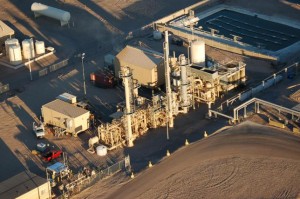 If you're already hosting the three or four largest single sources of air pollution in the entire region you need new large industrial sources of crap like a hole in the head. Likewise, if you've already violated the Clean Air Act for decades the last thing you need are new large sources of smog-producing pollution. But that's exactly what's happening with the announcement last week that a new Liquified Natural Gas (LNG) plant is being proposed for Midlothian's Railport Industrial Park, located between Midlothian and Venus on Highway 67, directly below, and upwind, of the Dallas-Tarrant County line.
If you're already hosting the three or four largest single sources of air pollution in the entire region you need new large industrial sources of crap like a hole in the head. Likewise, if you've already violated the Clean Air Act for decades the last thing you need are new large sources of smog-producing pollution. But that's exactly what's happening with the announcement last week that a new Liquified Natural Gas (LNG) plant is being proposed for Midlothian's Railport Industrial Park, located between Midlothian and Venus on Highway 67, directly below, and upwind, of the Dallas-Tarrant County line.
Applied Natural Gas Fuels (ANGF) put out a press release on March 21st that touted the purchase of 31 acres for a facility that would house "five liquefaction units, each able to produce 86,000 gallons of fuel daily, and total onsite storage of 1.5 million LNG gallons."
"In preparation of building the facility, which was announced last September, ANGF has purchase orders for all long-lead time items, such as storage tanks, production skids and electric motors and compressors, the company said.
The plant seeks to supply both road transportation and other off-road high-horsepower applications, such as rail, marine, mining, remote power generation and oilfield exploration/production (E&P) operations."
LNG plants take natural gas and cool it to minus 260 degrees F, at which point it becomes a liquid. This allows the industry to be able to store and move it compactly. It's been described as reducing the air out of a beach ball to shrink it to the size of a ping pong ball. But it also greatly increases the chances of accidents. If there's a leak or spill from a tank or pipeline the LNG would convert back to a gas. As it diluted with air, the natural gas/air mixture could become potentially explosive if the concentration of natural gas in air reached between 4% and 17%. In this range, any source of ignition (cell phone, cigarette lighter, attic fan, light switch, auto or boat engine spark plug, carpet spark, etc.) could ignite a vapor cloud and impact a large area.
ANGF already operates an LNG plant in Topock, Arizona, only three miles on the other side of California's border – and tougher regulations. At the same time it's building its new facility in Texas, the company is also doubling the capacity of the Arizona plant. According to an online document about the company's current operations from the Southern California Air Pollution Control District,
"…the gas must be stripped of impurities until it's over 98% methane. Co2, H2S, other sulfur components, moisture, mercury, and particles are stripped via acid gas removal and disposal, gas dehydration, mercury removal, and particle filtration…. The emissions associated with these processes include CO, VOC, SOx, NOx, H2S, particulates, and many toxic organic compounds."
That's Carbon Monoxide, a poison everyone's familiar with, Volatile Organic Compounds, a smog-producing class of chemicals like Benzene and Toluene, many of which are also carcinogenic, Sulfur Dioxide, a respiratory irritant which also causes acid rain, Nitrogen Oxide, a smog-producing respiratory irritant, PM pollution that's been linked to everything from heart attacks to Parkinson's, Mercury, a notorious neurotoxin, and oh yes, Hydrogen Sulfide, or "sour gas," a highly toxic and flammable poison that causes pulmonary edema at low concentrations and death at high ones.
We don't have specific annual volumes of those pollutants for the Midlothian plant yet, and may never get them if the facility receives a standard permit with only an upper ceiling of emissions, but LNG plants use a lot of energy, and therefore have the potential to emit a lot of air pollution. It appears that the Midlothian plant will be burning natural gas for its power, including huge gas turbine compressors. At much larger LNG export plants proposed for the coasts, these compressors have been the subject of a lot of concern. Last November, a Canadian wildlife conservation group released a report on a string of proposed LNG plants for British Columbia that estimated the facilities would be burning most of the gas used in the Province,
"The report, Air Advisory: The Air Quality Impacts of Liquefied Natural Gas Operations Proposed for Kitimat, B.C., concluded LNG plants permitted to operate primarily with natural gas will collectively burn 60 per cent of all the natural gas burned annually in B.C.
The report concluded nitrogen oxide emissions from the LNG plants would increase 500 per cent above existing levels. Nitrogen oxide emissions create acid rain, which harms waterways and fish and creates smog, which causes respiratory problems for children and the elderly, the report states.
The report also concluded natural gas driven LNG plants will increase emissions in the Kitimat area of volatile organic compounds, carbon monoxide and sulphur dioxide."
As a result of these kinds of concerns, the Canadian government committed to spending over a half million dollars on a study of how the gas industry will affect air quality in this part of British Columbia.
The Midlothian plant will be much smaller, put its impact on local and regional air quality could still be substantial depending on the design and technology. Industrial Hydrogen Sulfide and VOCs are not something you want wafting into your backyard, and anything that makes more smog is bad news for the entire DFW region.
Locating in Railport – itself a piece of heavy-metal contaminated ranch property bought and developed by TXI to prevent further liability issues – the LNG plant adds to the inventory of polluters that call Midlothian home. Three large cement plants, a steel mill, a gas power plant, and other smaller entities have made sure the city is the closest thing to a DFW Ship Channel that we have. Collectively, these facilities emit a kind of super plume of air pollution that spews north into the middle of the Metromess during most of the year. If you live anywhere from SW Dallas to NW Tarrant County, you're already breathing the pollution from Midlothian industry. How much the ANGF facility will add to that plume is not yet known, but any increase is going in the wrong direction. Stay tuned.
New Studies Link Air Pollution To Diabetes and High Blood Pressure in Pregnancy
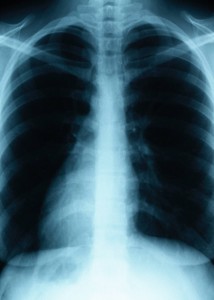 Sometime during the 1990's it became evident that air pollution was more than just a threat to your lungs. Studies begin linking bad air with brain disorders, heart attacks, and hormonal disruption. This pool of research is now very deep and this month got a little deeper with publication of studies linking air pollution to Type 2 Diabetes and high blood pressure.
Sometime during the 1990's it became evident that air pollution was more than just a threat to your lungs. Studies begin linking bad air with brain disorders, heart attacks, and hormonal disruption. This pool of research is now very deep and this month got a little deeper with publication of studies linking air pollution to Type 2 Diabetes and high blood pressure.
From the University of Maryland comes a report that concludes air pollution increases inflammation of the heart which leads to diabetes when combined with a high fat diet – the kind so many Americans are still eating. Sedentary mice were fed the high-fat diet and then forced to breath Beijing-like levels of air pollution. Exposure to that bad air, primarily high levels of particulate matter, increased the likelihood of the mice developing diabetes by 2 to 4 times, and increased he severity of the disease as well. But hey, we're in America where the air is so much cleaner than China's, right? According to Dr. Sanjay Rajagopalan, Professor of Cardiovascular Medicine at the University of Maryland,
"….there have been at least 15 studies that have actually extended these observations of experimental models to large populations, and some of these have been done obviously in North America where we live, you know, in a relatively clean environment from an atmospheric standpoint thanks to regulation put together by Congress in the 1970s..but despite that even with the levels you’re exposed to with this continent we still see continuing associations between inhaled particulate matter content and susceptibility to type 2 diabetes.
Meanwhile, researchers at the University of Florida found that exposure to four air pollutants, including two specific types of fine and coarse particulate matters, sulfur dioxide and carbon monoxide, may be more toxic to pregnant women than breathing in cigarette smoke.
"Fetal development is very sensitive to environmental factors," said Xiaohui Xu, an assistant professor of epidemiology in the university. "That is why we wanted to do this research. Hypertension (high blood pressure), in particular, is associated with increased morbidity and mortality, causing a lot of problems for the mother and fetus, including preterm delivery."
Xu and his colleagues matched up 22,000 births in Jacksonville Florida in 2004-2005 with EPA pollution data. After controlling for other risk factors like income and exposure to smoking, they concluded that exposure to air pollutants throughout the first two trimesters of pregnancy increased women's risk of developing one of these conditions as much or more as smoking itself.
So how much influence do environmental factors have on modern health? Dr. Rajagopalan says a lot:
"…there’s a growing body of data that’s suggesting that whether it’s water or air or things that you eat, the packages that food is packed in…all of these things have ever so slight effects on your susceptibility to a number of chronic diseases. And these are things that are the reality, but are really the primary prevention measures where if you took care of these issues, you might not have problems to begin with. So these are easy solutions, clearly when you start to think about it, but also equally complex in terms of implementing at a societal level, because it takes so many different stakeholders to agree and to make these changes, you know, it tends to be a lot more complex.
Yep. We noticed.
What Would A TXI Sale Mean to DFW Air?
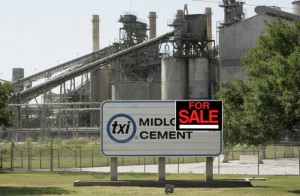 According to the Dallas Morning News, TXI Cement is up for sale with at least two possible buyers, Vulcan and Holcim, mentioned in last Friday's story. Along with kilns in California, the company's Midlothian and Hunter, Texas cement plants are on the block as part of the deal.
According to the Dallas Morning News, TXI Cement is up for sale with at least two possible buyers, Vulcan and Holcim, mentioned in last Friday's story. Along with kilns in California, the company's Midlothian and Hunter, Texas cement plants are on the block as part of the deal.
As the news reports note, the timing is a little strange in that the construction industry, the barometer for all things cement, is only now rebounding out of its Great Recession doldrums, and TXI's profits are nowhere near it's pre-collapse heights. It could be that the latest generation of the Rogers' family to run the firm isn't all that interested in keeping it running, or that the two largest and restless corporate shareholders, who now own 51% of the company, are anxious to deal.
Of the two suitors listed in the News article, Holcim is one of the industry's international giants that has the large cash reserves, while Vulcan is smaller, US-based, and considered more of an Aggregates business with some cement plants in Florida.
On the other hand, Holcim already operates a huge cement plant across the street from TXI in Midlothian. It's hard to imagine the company needing to double its manufacturing capacity in DFW. But perhaps TXI's California market share makes the deal look attractive as a whole and the Midlothian plant would be spun off to a third party. For Vulcan, it looks like a way to go from a regional powerhouse to a national one by buying plants in two large, influential state economies.
Holcim is a leader in the new waste-burning revival within the cement industry. Its Midlothian cement plant already has a permit to burn a long list of industrial wastes, although it's not as long as TXI's. During the economic downturn,TXI was given permission by Rick Perry's TCEQ (without public notice or participation) to burn a variety of new wastes like car "fluff" and plastics , but reportedly didn't have the capital to build the infrastructure needed to convey the wastes to the kilns. A new owner like Holcim might have the cash to fix that, and fixing that would mean lots more waste-burning. Buying TXI's Midlothian plant would mean buying its waste-burning permits as well, opening up new waste markets for Holcim without having to go to the trouble of a permitting process.
If Vulcan or some other middle-size player buys TXI, you can be sure they'll run the plants 24/7 as much as possible to recoup their investment and take advantage of better economic times. More production equals more air pollution, even with more modern controls forced by recent clean air plans and citizen campaigns.
But it's also possible to imagine a scenario where Holcim buys TXI, uses it's Midlothian limestone quarry to add to its own local reserves, but doesn't necessarily have the incentive to run both cement plants into the ground to justify the purchase price.
A sale of TXI by the Dallas-based Rogers family would be milestone in the industry, and in North Texas. TXI opened its first cement kiln in Midlothian in 1960. You can still see it there on Hwy 67, along with three other, older "wet" kilns that operated for 48 years before being shut down in 2008. They're all scheduled to be demolished later this year, leaving only the circa-2000 TXI Kiln #5 as a landmark. The times, they are a changin'. Stay tuned.
Better Living Avoiding This Chemistry: An Industrial Toxic Primer
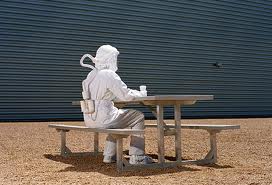 Even though this EcoNews article is about air poisons that result from fossil fuel production, it applies to just about any combustion source, including cement plants, manufacturing plants, vehicles, and so on. It's a pretty good top ten list, although you wonder why Dioxins and Furans got left off, since they're toxic by the gram instead of pound. Also missing is Particulate Matter as a stand alone threat, although it gets a shout out as a by-product. Nevertheless, these are the among the most dangerous pollutants that have caused and are still causing a lot of problems in North Texas and elsewhere:
Even though this EcoNews article is about air poisons that result from fossil fuel production, it applies to just about any combustion source, including cement plants, manufacturing plants, vehicles, and so on. It's a pretty good top ten list, although you wonder why Dioxins and Furans got left off, since they're toxic by the gram instead of pound. Also missing is Particulate Matter as a stand alone threat, although it gets a shout out as a by-product. Nevertheless, these are the among the most dangerous pollutants that have caused and are still causing a lot of problems in North Texas and elsewhere:
1. Benzene
Benzene is a well-established carcinogen with specific links to leukemia as well as breast and urinary tract cancers. Exposure to benzene reduces red and white blood cell production in bone marrow; decreases auto-immune cell function (T-cell and B-cells); and has been linked to sperm-head abnormalities and generalized chromosome aberrations.
Benzene is one of the largest-volume petrochemical solvents used in the fossil fuel industry. It is a major component in all major fossil fuel production: oil, coal and gas. People are exposed to it from inhaling automobile exhaust and gasoline fumes, industrial burning such as oil and coal combustion, and exposure to fracking fluids.
There's a recent Emory University study concluding that risk for leukemia fell with every mile between a person's home and facilities that release benzene.
2. & 3. Sulfur Dioxide (SO2) and Nitrogen Oxides (NOx)
Sulfur dioxide (SO2) and nitrogen oxides (NOx) are two primary examples of particle-forming air pollutants (particulate matter). Particulate matter is known to contribute to serious health problems, including lung cancer and other cardiopulmonary mortality. SO2 and NOx are both highly toxic to human health, and contribute directly to thousands of hospitalizations, heart attacks and deaths annually.
SO2 is particularly dangerous for children. Studies correlate SO2 emissions from petroleum refineries—even in lower exposure levels over time —to higher rates of childhood asthma in children who live or attend school in proximity to those refineries. Similarly, small particles of NOx can penetrate deeply into sensitive lung tissue and damage it, causing premature death in extreme cases. Inhalation of such particles is associated with emphysema and bronchitis.
4. Petroleum Coke (Pet Coke)
Pet coke is a by-product of oil processing that's also used as a fuel. It's a heavy dust which resembles coal. It's burned in power plants and cement plants. It contains dozens of dangerous chemicals and heavy metals, including chromium, vanadium, sulfur and selenium. It's a huge contributor to particulate mater and NOx and SOx formation
5. Formaldehyde
Formaldehyde is a carcinogen with known links to leukemia and rare nasopharyngeall cancers, according to the International Agency for Research on Cancer. Formaldehyde is highly toxic regardless of method of intake. It is a potent allergen and genotoxin. Studies have linked spontaneous abortions, congenital malformations, low birth weights, infertility and endometriosis to formaldehyde exposure. Epidemiological studies link exposure to formaldehyde to DNA alteration. It is also contributes to ground-level ozone.
Independent studies, have detected dangerous levels of formaldehyde in both wastewater and ambient air emissions from fracking operations. One researcher, with the Houston Advanced Research Center, said reading from one test site in North Texas, “astoundingly high,” and, “I’ve never heard of ambient (formaldehyde) concentrations that high… except in Brazil.”
6. Polycyclic Aromatic Hydrocarbons (PAHs)
In actuality, this is not a single listing—polycyclic aromatic hydrocarbons (PAH) is an entire class of toxic chemicals, linked together by their unique chemical structure and reactive properties.
Many PAHs are known human carcinogens and genetic mutagens. In addition, there are particular prenatal health risks: prenatal exposure to PAHs is linked to childhood asthma, low birth weight, adverse birth outcomes including heart malformations and DNA damage.
Additionally, recent studies link exposure to childhood behavior disorders; researchers from Columbia University, in a 2012 Columbia University study, found a strong link between prenatal PAH exposure and early childhood depression. Infants found to have elevated PAH levels in their umbilical cord blood were 46% more likely to eventually score highly on the anxiety/depression scale than those with low PAH levels in cord blood. The study was published in the journal Environmental Health Perspectives.
7. Mercury
Mercury is a dangerous neurotoxin emitted from coal-fired power plants and any other combustion source using coal for fuel – like the Midlothian cement plants. It damages the brain and the nervous system either through inhalation, ingestion or contact with the skin. It is particularly dangerous to pregnant women and children. It is known to disrupt the development of the in-vitro brain. In low doses, mercury may affect a child’s development, delaying walking and talking, shortening attention span, and causing learning disabilities. High dose prenatal and infant exposures to mercury can cause mental retardation, cerebral palsy, deafness and blindness. In adults, mercury poisoning can adversely affect fertility and blood pressure regulation and can cause memory loss, tremors, vision loss and numbness of the fingers and toes.
One out of every six women of childbearing age in the U.S. have blood mercury levels that could be harmful to a fetus, according to EPA reports. The EPA estimates that 300,000 children are born each year at risk for significant development disorders due to mercury exposure.
8. Silica (Silicon Dust/Sand)
Crystalline silica (“frac sand”) is a known human carcinogen; breathing silica dust can lead to silicosis, a form of lung disease with no cure. This is a hazard in the cement industry and threat to those living downwind of cement plants, and now it appears to be one for natural gas roughnecks and adjacent homeowners as well.
Silica is commonly used, in huge amounts, during fracking operations. Each stage of the process requires hundreds of thousands of pounds of silica quartz–containing sand. Millions of pounds may be used for a single well.
The presence of silica in fracking operations, simply put, is a major safety risk with a high likelihood of dangerous exposure. Case in point: researchers from the National Institutes of Occupational Safety and Health (NIOSH) recently collected air samples at 11 fracking sites in five different “fracking states” (CO, ND, PA, TX and AR) to evaluate worker exposure to silica. Every single site had measures higher than the NIOSH threshold for safe exposure—so high, in fact, that about one-third of the samples collected were even above the safe threshold for wearing a safety respirator mask. This was reported in May 2013 in the Journal of Occupational and Environmental Hygiene.
9. Radon
Radon is a colorless, odorless, tasteless radioactive gas which causes lung cancer. It is the second largest cause of lung cancer in the U.S. after cigarette smoking. About 20,000 people per year die from lung cancer attributed to radon exposure according to the National Cancer Institute. Further, there is no known threshold below which radon exposures carries no risk.
Radon exposure can come from a variety of natural sources. However, fracking (natural gas) represents a significant new and increased source of radon exposure to millions of citizens. Radon is released into local groundwater and air during fracking operations. It also travels through pipelines to the point of use—be it a power plant or a home kitchen.
The science behind radon release and exposure is complex but explained well here by Christopher Busby, the Scientific Secretary of the European Committee on Radiation Risk, who warns that radon dangers from fracking “have not been addressed properly (or at all) by the environmental impact statements published by the operators, or by the Environmental Protection Agency in the USA.”
10. Hydrofluoric Acid (HF) / Hydrogen Fluoride
Hydrofluoric acid (HF) is “one of the most dangerous acids known.” HF can immediately damage lungs, leading to chronic lung disease; contact on skin penetrates to deep tissue, including bone, where it alters cellular structure. HF can be fatal if inhaled, swallowed, or absorbed through skin.
The senior laboratory safety coordinator at the University of Tennessee said, “Hydrofluoric Acid is an acid like no other. It is so potent that contact with it may not even be noticed until long after serious damage has been done.”
Hydrofluoric Acid is a common ingredient used in oil and gas extraction.
Numerous studies, including recent ones conducted by both The Center for Public Integrity (CPI) and the United Steelworkers Union (USU) cite the oil industry’s abysmal safety record as a high risk factor for a major HF accident; over the past decade, more than 7,600 accidental chemical releases from refineries have been reported by the industry. In the past three years alone, a total of 131 “minor” accidents involved HF.
D-Day Minus 7: Dallas Gas Ordinance Countdown
Considering how little public notice there was, yesterday's Dallas City Council "public comment time" on the new gas-drilling ordinance was well-attended by residents supporting the Plan Commission Draft. Over two dozen people spoke in favor of the CPC recommendations, including the 1500 foot setback, and/or stronger language for parks and flood plains. Murky statements by the Mayor about whether speaking this week would disqualify you from also having your say at next week's public hearing immediately prior to the final Council vote kept other residents from going to the podium.
True to whatever consultant's media training rule book they're following, industry representatives waited until they thought citizen testimony ended to make their condescending case that citizens were relying only on fear and didn't really understand the fracking process. The problem with this strategy is that you have to pretend the previous 45 minutes of citizen testimony never happened, since it's always replete with references to new scientific studies showing increased health harms from fracking, or another connection with earthquakes, or just strange foamy crap falling out of the sky into your yard from the rig down the street. It turns out the industry folks are the ones who don't really know the process.
And as fate would have it, citizens weren't through testifying. Right after telling the City Council how much West Dallas would lose out by not embracing fracking in its neighborhoods, up popped a West Dallas resident who said she wanted nothing to do with the industry, no matter how much money was involved. After another industry spokesman again said supporters of a stronger ordinance were just imagining harms they weren't really there, Sierra Club member Molly Rooke gave a devastatingly effective presentation on exactly how real harms to real people had forced her own group to acknowledge the dangers of gas pollution after initially endorsing natural gas as an entirely green fuel.
Unlike the staff briefing of two weeks ago, which allowed industry supporters on the Council to bloviate at will over what a crime it was to limit drilling in Big D, nobody behind the horseshoe did any talking except the Mayor, who was perfunctory in his opening and closing remarks and didn't give any clues as to his position on the CPC draft. According to Rawlings, it was his idea to have this "public comment time" prior to the final hearing so there wouldn't be the pile-up there was during the Trinity East vote, where you felt more like you were a cog in an assembly line instead of a citizen participating in one the small pageants of American democracy.
At the end of the meeting, Texas Campaign for the Environment members unfurled a banner urging Rawlings to "Be Strong," which was quickly confiscated by the City Hall Police Rapid Protest Response Team. Here's the Dallas Morning News' muted coverage of the event.
Because of the weather, Dallas Residents at Risk is waiting until next Monday to gin up a final push for passage of the Plan Commission draft going into Wednesday's final public hearing and vote beginning at 1 pm at City Hall. Please stay tuned for details about how you can express your public support and send a message to the Council to pass a strong ordinance. We know we sound like a broken record, but if you haven't sent a quick e-mail to the Mayor yet, you can click here and do so within a minute pretty painlessly. If you want a short explanation of what's going and what votes are where, you can read this previous post and get caught-up.
We have only a week to make sure our last year's worth of hard uphill slogging through corruption, double-dealing, and aggressively ignorant bureaucracies is not in vain. Please help us make it the last 1500 feet.
Downwinders Had A Good Day in Court Battling EPA Over Cement Plant Rules
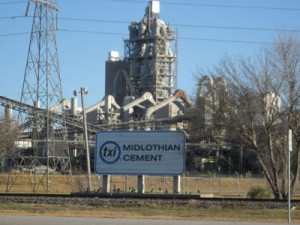 Downwinders has been trying to get new emission limits for cement plants since the mid-1990's. We're still trying.
Downwinders has been trying to get new emission limits for cement plants since the mid-1990's. We're still trying.
The first real reform in those rules during the Clinton Administration were pathetically inadequate. Downwinders and other groups assisted by DC-based Earth Justice sued to get them strengthened. We won. When new rules finally emerged from EPA in 2009, they were much better. Many of you came out to the historic national hearing at the DFW Airport hotel to testify in favor of them.
These rules were on their way to being signed by President Obama when they got hijacked by industry at their stop at the Office of Management and Budget, which must review all new regulations. When they emerged, they were unrecognizable in many ways, with deadlines pushed back by years and the important Particulate Matter standard being significantly weakened.
Once again, we're back in court trying to get these watered down rules thrown out. Last week, the DC appeals court that usually takes up federal regulatory fights heard oral arguments from both sides, and even the Republican judges on the panel were skeptical of the Administration's rewrite job.
Reprinted in full below is an inside-the-Beltway account of the proceedings that gives you some idea of what's at stake and what a good day citizens and their representatives enjoyed in court. No date on when to expect a ruling. Even then, if we win, the rules go back to EPA to be rewritten again, albeit with more judicial constraint…theoretically at least.
Judges seem skeptical of EPA claims in cement emissions case
Jeremy P. Jacobs, E&E reporter
Published: Thursday, October 24, 2013
Public health advocates argued in court today that U.S. EPA unlawfully weakened and delayed air standards for cement manufacturers, appearing to gain some traction with a panel of federal appellate judges.
The Natural Resources Defense Council contends EPA caved to industry pressure when it revised its National Emission Standards for Hazardous Air Pollutants, or NESHAP, for portland cement kilns and pushed back its compliance date by two years.
EPA's standards apply to several pollutants, including particulate matter, mercury and other acid gases. The agency revised the particulate matter standard after a court ruling in 2011, but advocates claim the agency did more than the ruling required.
James Pew of Earthjustice, representing the NRDC, told the U.S. Court of Appeals for the District of Columbia Circuit that EPA "gratuitously weakened the particulate matter standard" and violated the "plain and literal meaning" of the Clean Air Act.
Further, he said, many of the issues EPA addressed with its changes "didn't come up" in the previous case.
The cement NESHAP has long been the subject of controversy and litigation.
The kilns are one of the top sources of man-made mercury emissions in the United States. Public health advocates forced EPA to set the standards in a 2010 lawsuit, and when the agency issued the standards later that year it said they would prevent 960 to 2,500 deaths per year.
Industry, however, quickly challenged the standards at the D.C. Circuit. In December 2011, the court ordered EPA to reconsider the standards by taking commercial incinerators that burn solid waste out of its calculations. However, the court largely left the standards in place, including their 2013 compliance deadline (E&ENews PM, Dec. 9, 2011).
When EPA recalculated the standard for particulate matter, the advocates claim the agency made it less stringent. Additionally, EPA reached a settlement with the portland cement industry to delay compliance to September 2015 for all pollutants — not just particulate matter (Greenwire, Dec. 7, 2012).
Public health advocates challenged both actions, as well as a shift from continuous monitoring to one-time annual stack testing for compliance — which also changed the particulate matter standard. The environmentalists also question the standard's inclusion of an "affirmative defense" that protects kilns from citizen lawsuits if they violate the standards during an unavoidable malfunction.
Each issue came up today before a three-judge panel, which included two judges who are considered potential future Supreme Court nominees. The panel appeared receptive to some of the advocates' arguments but not to others.
For example, Judge Brett Kavanaugh, one of the country's leading conservative jurists, appeared skeptical of EPA's decision to delay standards for mercury and other gases to 2015, even though the Clean Air Act says standards must take effect within three years. The 2010 standards for those pollutants, which weren't affected by the D.C. Circuit ruling in 2011, should be in effect now.
"I don't understand," said Kavanaugh, a Republican appointee. "I need help. I don't understand the interrelatedness."
Further, Senior Judge Harry Edwards, a Democratic appointee, said EPA could have easily linked the standards by saying it wasn't "practicable" to meet some without meeting the others. But EPA, Edwards said, never made that argument in the rulemaking.
"I'm really not following this," Edwards said. "Where does the agency make the finding … that compliance couldn't be done practicably?"
Matthew Oakes of the Department of Justice, representing EPA, countered that all the standards are related because the pollution control technology required to limit particulate matter also controls emissions of mercury and other gases. Therefore, it didn't make sense to require kilns to install technology for mercury, for example, before it knew the final particulate matter standard, he said.
That argument was echoed by Carter Phillips of Sidley Austin LLP, representing the cement industry, which intervened in the case.
"You cannot implement any of them in a one-off system," he said.
It was unclear which way the judges were leaning with regard to the advocates' arguments surrounding the particulate matter standard itself. But they appeared receptive to their challenge to EPA's affirmative defense.
Oakes argued that the advocates lacked standing to challenge the affirmative defense, meaning they had failed to prove how they would be injured by it. That notion was flatly rejected by the panel, which said the defense would allow kilns to, at times, exceed the standards, which would harm human health. Therefore, the advocates have grounds to bring the lawsuit, the judges said.
The panel was also skeptical of EPA's arguments on the substantive issue of whether EPA could create the affirmative defense in the first place. Judge Srikanth Srinivasan, President Obama's first appointee to the D.C. Circuit and a leading liberal judge, contended that the Clean Air Act didn't grant EPA that ability.
"This authority wasn't delegated to the EPA to begin with," he said.
Study: Low Levels Of Incinerator Pollution Linked to Premature Births
 A new study being published in the November issue of Epidemiology concludes that even low levels of pollution from solid waste incinerators causes an increase in premature births downwind.
A new study being published in the November issue of Epidemiology concludes that even low levels of pollution from solid waste incinerators causes an increase in premature births downwind.
Italian researchers examined over 21,000 births to women living within four kilometers of one of eight solid waste incinerators operating in the Emilia-Romagna region.
"Each newborn was georeferenced and characterized by a specific level of exposure to incinerator emissions, categorized in quintiles of PM10, and other sources of pollution (NOx quartiles), evaluated by means of ADMS-Urban system dispersion models. We ran logistic regression models for each outcome, adjusting for exposure to other pollution sources and maternal covariates.
Preterm delivery increased with increasing exposure….A similar trend was observed for very preterm babies. Several sensitivity analyses did not alter these results. Maternal exposure to incinerator emissions, even at very low levels, was associated with preterm delivery"
Now, you can reassure yourself that we have no single-purpose solid waste incinerators around these parts the way they do on he East Coast or Midwest, so we don't have to worry about this kind of threat. But that's not entirely accurate.
We do have solid waste incinerators in North Texas, they're just called cement kilns. And we have more incinerator capacity than anyone else in the country when it comes to cement kilns.
And, as it turns out, these cement kilns are expanding their lists of available "fuel" to include solid wastes, as well as coal – medical, municipal, and "hard to burn" plastics, as well as car parts, shingles and carpet remains. It's all part of the new wonderful world of commercial garbage burning. If the kilns happen to make some money in the process of turning themselves into under-regulated incinerators, well, all the better for their operators.
For example, and try not to throw up, in the Philippines, the local cement plant is marketing the burning of "Holcimables." What are "Holcimables" you ask? They're "plastics – styrofoam, sando bags, cellophanes and foil packs – textile and rubber." Yes, the same company that operates a cement kiln in North Texas is burning styrofoam in the name of environmental-friendliness in the Philippines. You can bet the Italian incinerators included in this new study were burning some of the same kinds of wastes with the same ingredients.
Burning stuff is bad, whether it's in an incinerator or a cement kiln. And industry is making it very hard to tell the difference.
World Health Organization: Air Pollution Causes Lung Cancer
 As of Thursday, the air you breathe CAN kill you, at least according to the World Health Organization, which officially classified air pollution as a cause of lung cancer. The move came after the group released a report earlier this year estimating that over 220,000 people died from lung cancer worldwide from exposure to bad air. Most of those deaths are occurring in countries in Asia.
As of Thursday, the air you breathe CAN kill you, at least according to the World Health Organization, which officially classified air pollution as a cause of lung cancer. The move came after the group released a report earlier this year estimating that over 220,000 people died from lung cancer worldwide from exposure to bad air. Most of those deaths are occurring in countries in Asia.
Mostly these deaths are due to Particulate Matter pollution, the ubiquitous tiny particles of soot that are produced when things burn, like gas in cars, coal or gas or waste in power plants and cement kilns, and diesel engines and flares in the the gas fields.
Researchers have been producing one study after another for years linking a variety of illness and diseases to various ingredients of dirty air and specifically, Particulate Matter. Parkinson's Disease and other nerve and brain-related ailments, heart attacks and strokes, and of course respiratory problems have all been blamed on PM, but this is the first time it's been classified as a carcinogen. Most scientists in the field believe that there's really no level of exposure to the pollution that's completely "safe."
PM levels in DFW are generally low, but they've been rising over the last couple of years, and those measured levels are based on all of two monitors for all of the Metromess, so they could mask hot spots downwind of large sources (think Midlothian, compressors, and busy freeways). The EPA has proposed a new federal standard that's much lower than the current one, but it has yet to be implemented.
New National Report: Texas is Source of Over 50% of Total US Fracking Pollution
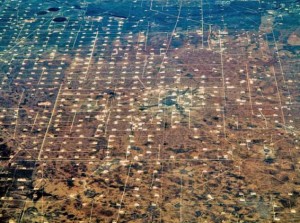 While most of the national publicity surrounding fracking over the past couple of years has involved documenting its encroachment into the Midwest and East Coast, a new first-of-its-kind report demonstrates why Texas is still the center of the oil and gas industry's universe.
While most of the national publicity surrounding fracking over the past couple of years has involved documenting its encroachment into the Midwest and East Coast, a new first-of-its-kind report demonstrates why Texas is still the center of the oil and gas industry's universe.
Last week the Environment America Research & Policy Center released "Fracking by the Numbers: Key impacts of Dirty Drilling at the State and National Level." As far as we can tell, it's the first systematic collection of quantifiable state-by-state data on the environmental costs of fracking in the entire US – the amount of water used in drilling operations, the amount of air pollution produced, the amount of acreage devoted to leases, etc.
Of course, the numbers all come from either the annual self-reporting industry performs for state and federal regulators, or those regulators themselves, so there's a good chance they're being under-estimated. Nevertheless, the total numbers are still huge and shocking. And what really catches the eye in the state-by-state breakdowns is just how much the operations around us here in Texas contribute to those huge and shocking numbers. We're not just the Belly of the Beast. We're the belly, upper and lower intestines, bowels, and open-throated mouth of the beast.
Number of Wells:
Of the almost 82,000 wells drilled across the country since 2005 (when the Energy Act with the "Halliburton Loophole" included was passed and signed), fully 34,000 have been drilled in the Lone Star State. The second closest state is Colorado with a little over 18,000.
Think things have slowed down and moved elsewhere? Of the 22,300 wells drilled since 2012, 13,500 of them have been in Texas. Colorado again comes in second with 1,900.
Acres of Land Damaged:
130,000 acres out of a US total of 360,000 acres. Colorado is second with 50,000.
Amount of Water Used
Out of a national total of 250,000,000,000 gallons of water used to frack wells, Texas accounts for 110,000,000,000. Pennsylvania is second at 30,000,000,000 gallons.
Amount of Waste Water Produced
Out of a national reported total of 280,000,000,000 gallons (that's 280 billion) of unusable toxic wastewater that needed to be disposed of permanently in injection wells, Texas accounts for 260,000,000,000 gallons. North Dakota is a distant second with 12,000,000,000.
Air Pollution
None of these figures includes totals from other kinds of facilities in the gas cycle, like compressors or pipelines, or storage tanks – just drilling pad operations.
Particulate Matter
Approximately 8,000 tons in Texas out of nationwide total of 13,000.
Nitrogen Oxide (smog-forming)
100,000 tons in Texas out of 170,000 for the entire US.
Carbon Monoxide
153,000 tons in Texas out of a US total of 250,000 tons.
Volatile Organic Compounds (smog-forming and toxins)
14,000 tons in Texas out of 23,000 nationwide.
Sulfur Dioxide (acid rain, respiratory irritant)
300 tons in Texas out of a total of 600 tons nationwide.
Greenhouse Gases
40,000,000 tons in Texas out of a US total of 100,000,000.
When a single state accounts for more than half of the wells, the waste water, and the entire country's air pollution burden from fracking, you understand why campaigning against the industry's practices in Texas is the political equivalent of fighting behind enemy lines. It makes recent victories like the defeat of the Trinity East permits and the adoption of a tougher draft Dallas gas ordinance all the more remarkable, and important.
Beginning in 2006, many of us were caught off-guard by the invasion of wells that swept eastward into the metropolitan DFW area. We didn't know enough to know what questions to ask, or we didn't want to ask them. Now, living in the largest urban gas play in the US, and inventorying these kinds of mind-numbing statistics, we don't have any excuses. Fracking represents one of the most profound environmental and public health challenges ever to confront DFW or Texas. The most important question now is what we intend to do about it.
Big D’s BFD
 Did you feel the ground shifting under your feet yesterday around 5 pm? It was another one of those local earthquakes caused by fracking. The epicenter was Dallas City Hall. Damage to the gas industry's rhetoric and credibility was extensive.
Did you feel the ground shifting under your feet yesterday around 5 pm? It was another one of those local earthquakes caused by fracking. The epicenter was Dallas City Hall. Damage to the gas industry's rhetoric and credibility was extensive.
By a vote of 14 to 1, the Dallas Plan Commission pronounced the permissive "Fort Worth Model" of regulating the drilling and production of natural gas in the Barnett Shale dead. The passing was definitive. As John Cleese might say, "This paradigm is no more…it has ceased to be…this is an EX-paradigm."
It didn't go down without a fight. Up until the very final hours of debate over language in the City's proposed new gas ordinance, staff was still offering weaker versions of rules to Commission members because "that's the way Fort Worth did it." They were all rejected in favor of stricter standards as part of what has the potential to be the most protective ordinance in the Barnett Shale.
Now all we have to do is get eight Dallas City Council members to help us realize that potential.
The draft passed yesterday isn't 100% of what residents want, and in one case doesn't even match the level of protection Dallas itself started out with in 2007. It still provides paths through the bureaucracy for drilling in parks and flood plains, instead of outright bans, and despite staff assurances, the chemical disclosure language isn't foolproof. But to see it only through the lens of what it's not yet doing is to ignore the huge impact of what it already does. Coming from the largest city in the Shale, the Dallas draft immediately offers a modern, tougher alternative to Ft. Worth's submissiveness for dealing with the problems of mining gas in urban environments. To quote our Vice-President, it's a B.F.D. Some of the highlights include:
1) A 1,500 property line-to-property line setback from neighborhoods and other protected uses, matching the most protective setbacks in the Barnett Shale. It can only be reduced to a minimum of 1000 feet with a variance, and that's only possible with 12 out of 15 council votes. Notice of any permit must go out in English and Spanish to all mailing addresses within 2000 feet and the applicant must hold a neighborhood meeting where the project is fully explained.
2) Electrification of all motors and engines on a drilling site. If operators want to make an exception and use combustion engines, they have to show why electrification isn't feasible, and the City has to agree.
3) Tough restrictions on where gas compressor stations can locate – only in heavy industry zoning districts, with the same 1,500 foot setbacks from neighborhoods and all other protected uses, fully enclosed, and they must use electric engines, not diesel or gas. Thanks to some quick pushback by residents and their allies on he Commission, we were able to win back all the rules that staff had excluded in their first take only 24 hours before the vote.
4) A ban on any injection wells in the City of Dallas.
5) A ban on fracking waste pits.
6) Requirements for a road repair agreement before a permit is even considered. This is above and beyond any other insurance or bonding requirement.
7) A recommendation to the Council that it establish a local air pollution off-sets program that would include natural gas facilities. Such a program would be the first of is kind in the nation and close a Clean Air Act loophole that exempts these facilities from participating in the federal off-sets program for smoggy "non-attainment areas."
8) Baseline testing of water, soil, air, and noise at every proposed site.
9) Individual non-toxic "tagging" of all fracking fluids used. Every operator will be required to put their unique chemical signature within the concoction they're pumping into the ground so that if any of it goes where it shouldn't, the offending well can be identified. It's DNA testing for fracking.
10) A recommendation to the Council that during drought conditions, it either charge substantially more for city water that's being used for fracking, or ban the use of city water for fracking all together.
11) A recommendation that the Council demand an additional letter of credit from operators beyond any other insurance or bond to cover uninsurable intentional acts of contamination, i.e. dumping waste into the Trinity River.
We're not in Cowtown anymore.
(There's not an online version of the final language up yet. We'll let you know when there is so you can look this thing over yourselves).
City attorney Tammy Palomino, always a reliable source of information, stated on the record that she believed the draft's language about chemical disclosure would cover all trade secrets, but we're not so sure. That's why we'll be asking the Council to add five simple words to this section that Ms. Palomino didn't: "with no exceptions for trade secrets."
Instead of banning drilling in the floodplain, the proposed ordinance makes it impractical, though not impossible. An operator would have to get a fill permit from the city, and approved by the Army Crop of Engineers, to build a mound that would elevate the entire drilling pad site out of the floodplain. Anyone who's seen the footage from Colorado's flooded gas plays over the last couple of weeks can identify the folly of this approach. What's to keep flood waters from eroding the elevated mound and taking the entire pad site down stream? Only the lack of a kind of levee-to-levee flood we've seen in Dallas before.
Park drilling provided the day's lesson in pretzel logic. A "protected use" includes a recreation area, "except when the operation site is on a public park, playground, or golf course." Then it's perfectly fine to have rig next to the swing set. Got it?
This is less protective than the original Dallas Park decision that preceded the notorious Suhm secret agreement with Trinity East. It called for the leasing of a park's mineral rights but banned surface drilling in any park. You could go under but not on. That's still the most sensible compromise but it went floundering for support yesterday.
Instead, the Park Board will have to request the City Council to hold "Chapter 26" public hearing, after which there must be a 3/4 vote of approval by the Council that officially concludes there's no other possible feasible use for the park land other than gas drilling.
Listening to the comments from many Commissioners right before the vote, one got the feeling that if they had to do it all over, they might not be so equivocal. Nevertheless, they all voted for the more convoluted approach. It's the most flawed part of the ordinance, especially in light of the outcry over allowing any drilling in any public park during the Trinity East fight.
With those exceptions, it was a banner day for residents who've been fighting this good fight for over three years now. It was the kind of day that after Trinity East's main lobbyist whined that the company just couldn't get the electrical hook-ups they needed (in the middle of Northwest Dallas by a major Interstate) during the public hearing right before the final vote, an influential conservative Commissioner successfully moved to amend the completed draft to make the section on mandatory electrification of compressor stations stronger. Ouch.
It was the kind of day when the only ally industry could muster among the 15 Plan Commissioners was the sometimes coherent Betty Culbreath, Dwaine Caraway's brand new gift to Dallas residents. Culbreath said she couldn't vote in conscience for a document that required so much from industry. She felt so passionate about the issue, she missed most of the Commission workshops over the past month or so where the ordinance language was debated. It'd be laughable except the council member who appointed her is now the Chair of the Council's Environmental Committee.
There's no official news about the timeline or process the Council will use to consider the draft now that it's been delivered to them. Despite the mostly winning day residents had on Thursday, its sobering to remember that we only got six votes to deny the Trinity East permits. We need at least two more to make sure this good ordinance stays intact, or gets even stronger.
Such a lopsided Commission result gives us a great running start to get those votes. Backsliding by Council members will be hard to pull-off publicly, although let's face it, some seem immune to embarrassment on this issue.
Cowtown circa 2008 will always be the industry's preferred template for regulation, because they mostly wrote the rules. Residents in the Shale now have a much more citizen-friendly 2013 Big D model they can use for counterpoint – if we can win ACT III of the Dallas Gas Wars.
